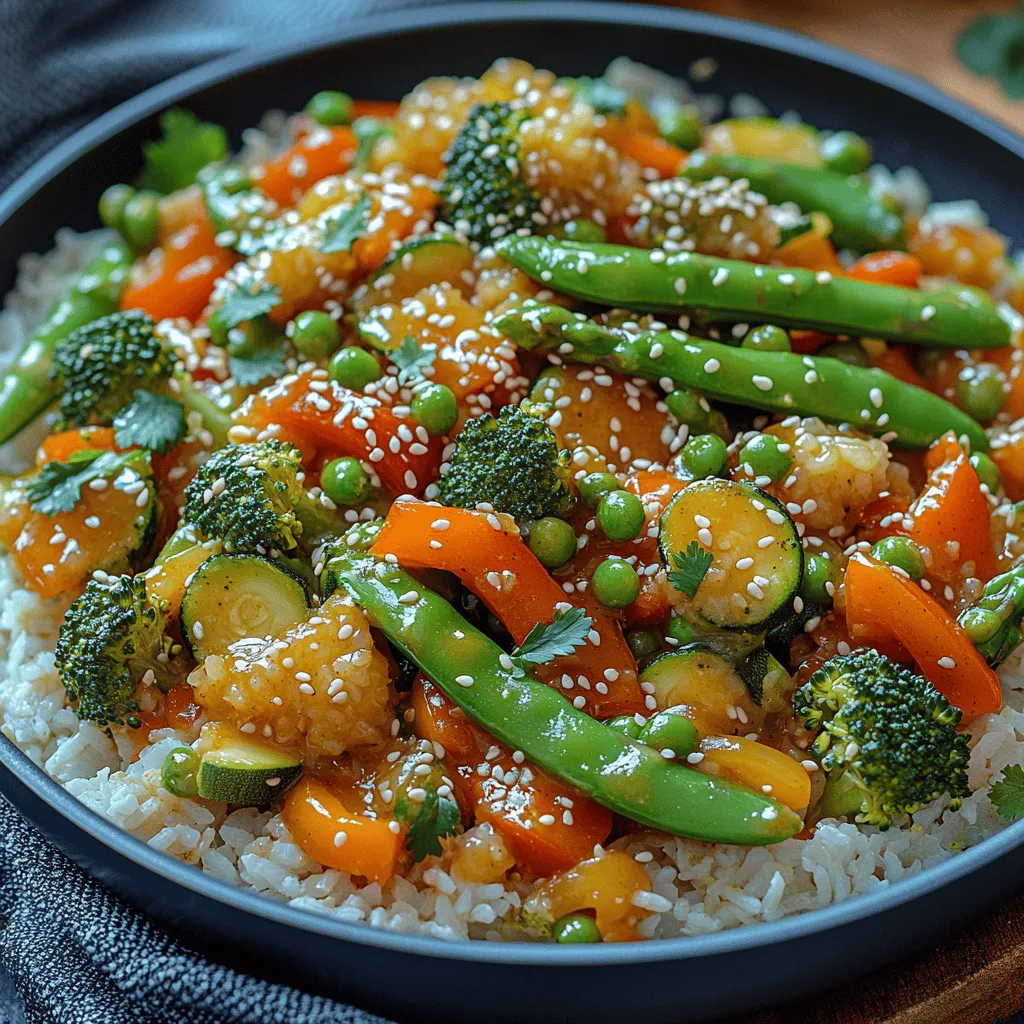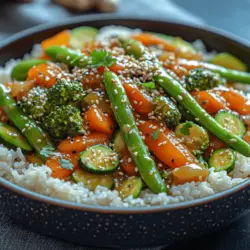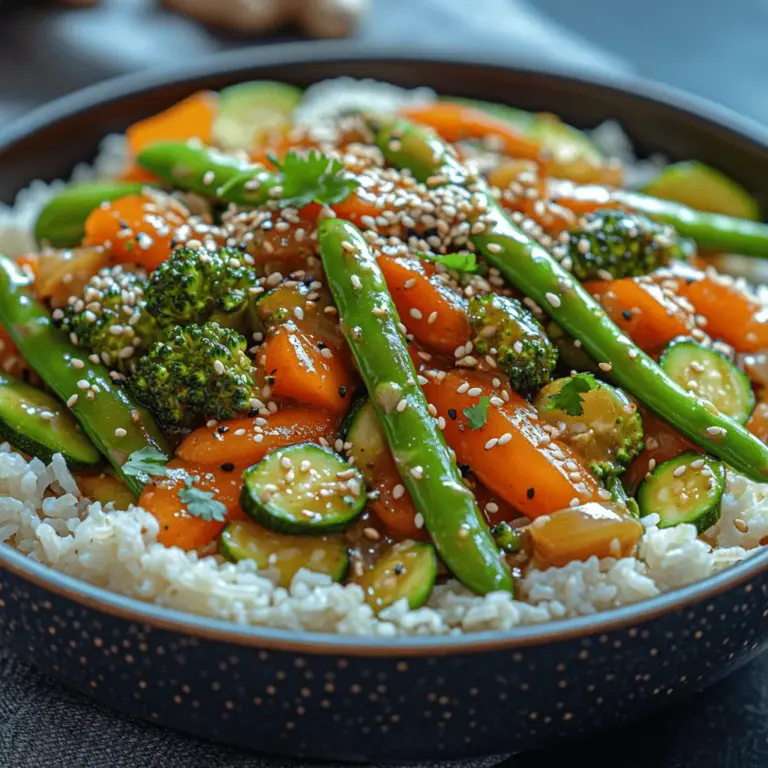Introduction
As the seasons shift from the chilly embrace of winter to the gentle warmth of spring, our plates should reflect the vibrant bounty of fresh produce that comes with this time of year. Seasonal eating not only supports local farmers but also ensures that we consume fruits and vegetables at their peak flavor and nutritional value. Spring heralds an abundance of tender greens, colorful vegetables, and aromatic herbs, making it the perfect opportunity to celebrate these ingredients in a delicious and healthy dish.
Enter the Spring Awakening Vegetable Stir-Fry—an exuberant medley of seasonal vegetables that not only looks stunning on the plate but also delivers a powerhouse of nutrients in every bite. This dish is designed to showcase the best of spring produce while offering a quick and satisfying meal option for busy weeknights or leisurely weekends.
Stir-frying is a cooking method that perfectly aligns with the principles of healthy eating. It allows for a quick cooking time, which helps retain the vibrant colors and crisp textures of vegetables while preserving their nutrients. The high heat and rapid cooking style maximize flavor, ensuring that every ingredient shines in this delightful dish. Whether you’re a cooking novice or a seasoned chef, this Spring Awakening Vegetable Stir-Fry is a fantastic way to embrace the season and enjoy a nutritious meal.
Understanding the Ingredients
The beauty of the Spring Awakening Vegetable Stir-Fry lies not only in its vibrant appearance but also in the variety of fresh ingredients it uses. Each vegetable brings its own unique flavor profile and a plethora of nutritional benefits. Here’s a closer look at the key ingredients that make this stir-fry a wholesome and satisfying dish:
Snap Peas
Snap peas are a delightful addition to any stir-fry, offering a crisp texture and sweet flavor. They are high in fiber, which is essential for digestive health, and packed with vitamins A, C, and K. These little pods also provide a good source of protein, making them a fantastic choice for plant-based meals.
Asparagus
Asparagus is a true spring vegetable, celebrated for its tender stalks and earthy flavor. It is rich in antioxidants, vitamins A, C, and E, and is known for its anti-inflammatory properties. This vegetable is also a good source of folate, which is important for cell repair and healthy growth.
Broccoli
Broccoli is a nutritional powerhouse, loaded with vitamins K and C, as well as fiber. Its unique combination of nutrients supports immune function and promotes healthy digestion. Stir-frying broccoli allows it to maintain its crunch while adding a bold flavor to the dish.
Baby Carrots
Baby carrots are not only adorable but also a great source of beta-carotene, which the body converts into vitamin A. This vitamin is essential for maintaining healthy vision and skin. Their natural sweetness enhances the overall flavor of the stir-fry, making them a favorite among both kids and adults.
Bell Peppers
Bell peppers bring a burst of color to the dish, along with a refreshing crunch. They are high in vitamins A and C while being low in calories, making them an excellent choice for anyone looking to boost their nutrient intake without adding excess calories. Their sweet and slightly tangy flavor complements the other vegetables beautifully.
Zucchini
Zucchini is a versatile vegetable that adds moisture and a mild taste to the stir-fry. Low in calories and high in hydration, zucchini is perfect for keeping the dish light and refreshing. Its soft texture when cooked balances well with the crunchier vegetables in the mix.
Preparation: Setting the Stage for Success
The key to a successful stir-fry lies in the preparation. Taking the time to set up your ingredients—known as mise en place—is crucial for a smooth cooking experience. This means washing, chopping, and organizing your vegetables before you begin cooking. By doing so, you’ll ensure that everything is ready to go when it’s time to stir-fry, allowing you to focus on the cooking process without interruption.
Washing and Chopping
Start by thoroughly washing each of your vegetables to remove any dirt or pesticides. For snap peas, simply rinse under cold water and trim the ends. Asparagus should be washed and then snapped at the natural breaking point, which removes the tough, woody ends. Broccoli needs to be cut into florets, and baby carrots can be left whole or sliced in half for quicker cooking. Bell peppers should be halved, cored, and sliced into strips, and zucchini can be sliced into half-moons or rounds, depending on your preference.
Organizing Ingredients
Once your vegetables are prepped, organize them in separate bowls or containers. This not only keeps your workspace tidy but also allows you to easily grab each ingredient as you need it. Remember that stir-frying is a quick process, so having everything within reach will help you maintain the pace needed for even cooking.
Cutting Uniformly
For the best results, aim to cut your vegetables into uniform pieces. This ensures that they cook evenly and at the same rate. For instance, if you slice the zucchini too thick while cutting the bell peppers too thin, you risk having one ingredient overcooked while the other remains crunchy. Aim for bite-sized pieces that are roughly the same thickness—about 1 inch is usually a good target.
The Cooking Process: A Step-by-Step Guide
With your ingredients prepped and organized, it’s time to start cooking. The first step in the stir-frying process involves heating the oil. Choosing the right type of oil is essential for achieving the best flavor and texture in your dish.
Heating the Oil
In a wok or large skillet, heat a tablespoon of oil over medium-high heat. You can choose between vegetable oil, which has a neutral flavor and high smoke point, or sesame oil, which adds a rich, nutty flavor to the stir-fry. If you opt for sesame oil, consider using a combination of both oils to balance flavor and cooking performance.
Once the oil is shimmering but not smoking, it’s time to start adding your vegetables. Remember, the order in which you add ingredients can impact the overall cooking time and texture, so it’s important to follow a strategic approach.
This introduction sets the stage for a delightful and nutritious Spring Awakening Vegetable Stir-Fry. In the following sections, we’ll dive deeper into the cooking process, exploring the step-by-step guide to stir-frying, along with tips for achieving the perfect dish every time. Stay tuned for more insights into this vibrant recipe that celebrates the flavors of spring.

Sautéing Aromatics: The Role of Garlic and Ginger in Flavor Development
When it comes to stir-fries, the foundation of flavor often lies in the aromatics. Garlic and ginger are quintessential components that enrich the taste of your Spring Awakening Vegetable Stir-Fry. Begin by heating a tablespoon of oil in your skillet or wok over medium-high heat. Once the oil is shimmering, add minced garlic and grated ginger, sautéing them for about 30 seconds until they become fragrant.
This step is crucial as it allows the essential oils from the garlic and ginger to infuse the oil, which will then coat the vegetables. The key is not to overcook these aromatics; burning them can lead to a bitter taste that detracts from the overall flavor profile. As the garlic turns a light golden brown, it signals that it’s time to introduce your vegetables.
Incorporating Vegetables: The Order of Adding Veggies for Optimal Texture
The order in which you add vegetables to your stir-fry significantly impacts their texture and flavor. Start with denser vegetables that require more cooking time, such as carrots and bell peppers. Sauté these for about 2-3 minutes until they begin to soften. Following these, add your broccoli florets, snap peas, or any other quick-cooking greens.
Cooking your vegetables in stages ensures that each one is cooked perfectly—crisp but tender, vibrant, and full of life. The total cooking time for the vegetables should ideally be around 5-7 minutes, depending on your desired level of doneness. Remember to keep the vegetables moving in the pan; this constant motion helps to prevent burning and promotes even cooking.
Creating the Sauce: Balancing Flavors with Soy Sauce, Rice Vinegar, and Honey/Maple Syrup
Now that your vegetables are nearly cooked to perfection, it’s time to create the sauce that will elevate your dish. In a small bowl, whisk together ¼ cup of soy sauce, 1 tablespoon of rice vinegar, and 1 tablespoon of honey or maple syrup. This combination strikes a delightful balance between salty, acidic, and sweet flavors that complement the freshness of the vegetables.
Once mixed, pour the sauce over your stir-fried vegetables, stirring well to ensure every piece is coated. Let the sauce simmer for another minute, allowing it to thicken slightly and adhere to the vegetables. If you prefer a thicker sauce, you can mix a teaspoon of cornstarch with a tablespoon of water and add it to the pan, stirring continuously until it thickens to your desired consistency.
Finishing Touches: How to Know When the Stir-Fry is Perfectly Cooked
The finishing touches are essential to ensure your stir-fry is not just good but exceptional. You’ll know your Spring Awakening Vegetable Stir-Fry is perfectly cooked when the vegetables are bright in color and retain a slight crunch. They should be vibrant green and tender but not mushy. Taste testing is also a critical step; adjust the seasoning if necessary, adding a pinch of salt or a dash more soy sauce to enhance the flavors.
Once everything is ready, turn off the heat and let the stir-fry sit for a minute to allow the flavors to meld together before serving.
Serving Suggestions: Making it a Meal
To transform your vegetable stir-fry into a complete meal, consider pairing it with a base like brown rice or quinoa. These whole grains not only provide complex carbohydrates but also enhance the dish’s nutritional value. For an even heartier option, serve it with cooked soba noodles or over a bed of cauliflower rice for a low-carb alternative.
Garnishing Options to Elevate the Dish Visually and Flavor-Wise:
To add a finishing flourish, consider garnishing your stir-fry with toasted sesame seeds, chopped cilantro, or sliced green onions. These additions not only enhance the visual appeal but also contribute layers of flavor—sesame seeds add a nutty crunch, while cilantro and green onions introduce a fresh zing.
Suggestions for Protein Additions:
For those looking to increase the protein content, consider adding tofu, chicken, or shrimp. If you opt for tofu, press and cube it before stir-frying to achieve a crispy texture. For chicken and shrimp, add them to the skillet before the vegetables, cooking them until done before proceeding with the rest of the recipe. This incorporation of protein will help make the dish more filling and satisfying.
Health Benefits of the Spring Awakening Vegetable Stir-Fry
Embracing a plant-based diet has numerous health benefits, and the Spring Awakening Vegetable Stir-Fry is an excellent example of how delicious and nutritious plant-based meals can be. The dish is filled with colorful vegetables, each providing essential vitamins, minerals, and antioxidants vital for overall health.
The Role of Colorful Vegetables in Promoting Overall Health:
Each color of vegetable represents different nutrients; for instance, orange carrots are rich in beta-carotene, while green broccoli is packed with vitamin K. This variety ensures that you are getting a broad spectrum of nutrients, promoting better health and well-being.
How Incorporating Seasonal Produce Can Enhance Nutritional Intake and Support Local Agriculture:
Using seasonal produce not only enhances the flavors of your dish but also supports local agriculture, which is beneficial for the environment. Seasonal vegetables are often fresher, more flavorful, and more nutritious, making your stir-fry even more enjoyable.
Variations and Customizations
The beauty of the Spring Awakening Vegetable Stir-Fry lies in its versatility. You can easily customize the recipe based on your preferences or what you have available in your pantry.
Exploring Different Vegetables That Can Be Used Based on Seasonality:
Feel free to experiment with seasonal vegetables—zucchini, asparagus, or even leafy greens like kale or Swiss chard can be excellent additions. This adaptability allows you to keep the dish exciting and aligned with your taste.
Suggestions for Altering the Sauce:
If you prefer a bit of heat, consider adding crushed red pepper flakes or a splash of sriracha to the sauce. Alternatively, if you’re looking for a different flavor profile, you could substitute the honey with agave syrup or coconut sugar for a unique twist.
Ideas for Making the Dish Gluten-Free or Vegan-Friendly:
For a gluten-free version, opt for tamari instead of soy sauce, ensuring that you maintain the depth of flavor without compromising dietary needs. This dish is naturally vegan, but if you add protein, ensure it aligns with your dietary preferences.
Conclusion
Cooking with fresh, seasonal ingredients not only brings joy to your kitchen but also enhances the quality of your meals. The Spring Awakening Vegetable Stir-Fry exemplifies how simple, wholesome ingredients can create a dish that is both nourishing and delicious. With its vibrant colors, diverse textures, and adaptable nature, this stir-fry is perfect for any occasion— whether you’re looking for a quick weeknight dinner or a colorful dish to impress guests.
Embrace the beauty of seasonal cooking, and let the Spring Awakening Vegetable Stir-Fry inspire you to explore new flavors and ingredients in your culinary journey. Enjoy the process of cooking, and savor the delightful tastes of fresh vegetables that celebrate the season!

